Service Facilities in Heritage Tourism: Identification and Planning Based on Space Syntax
Abstract
1. Introduction
2. Literature Review
2.1. LBS Data: Quantification of Tourism Service Facilities
2.2. Street Network Structure and Space Syntax
3. Materials and Methods
3.1. Study Area and Data
3.2. Spatial Variable of Street Network
3.3. Agglomeration Characteristics of POIs
3.4. Correlation between POIs and Street Network Structure
4. Results
4.1. Agglomeration of Tourism Service POIs
4.2. Structure of Street Network
4.3. Correlations between Tourism Service and Street Network
5. Discussion
6. Conclusions
- When historic street regions, not yet fully developed as tourist areas, are renovated per tourism planning, the regions with high levels of global integration and low total depth (i.e., high levels of traffic accessibility) can be prioritized in the deployment of tourist service facilities.
- Among the correlations between each type of POI and street network space syntax, the POIs related to entertainment, catering, and shopping facilities are not significantly correlated with control values. Therefore, these three types of facilities should be deployed outside traffic nodes to ensure traffic accessibility. Conversely, transportation and accommodation facilities should be established at traffic nodes.
- Land use and transportation should be developed in coordination. By connecting streets and improving the layout of transportation facilities, the accessibility of local traffic in historical districts can be improved. Thus, more locations can be provided for the setting of tourism service facilities, and the potential of urban land can be fully tapped.
Author Contributions
Funding
Institutional Review Board Statement
Informed Consent Statement
Data Availability Statement
Conflicts of Interest
References
- Cozma, A.-C.; Coroș, M.-M.; Pop, C. Mountain Tourism in the Perception of Romanian Tourists: A Case Study of the Rodna Mountains National Park. Information 2021, 12, 45. [Google Scholar] [CrossRef]
- Saarinen, J. Traditions of sustainability in tourism studies. Ann. Tour. Res. 2006, 33, 1121–1140. [Google Scholar] [CrossRef]
- Caamaño-Franco, I.; Suárez, M.A. The value assessment and planning of industrial mining heritage as a tourism attraction: The case of Las Médulas cultural space. Land 2020, 9, 404. [Google Scholar] [CrossRef]
- Bai, Y.; Liu, C. Study on the Economic driving Effect of Cultural Tourism Industry—A Case Study of Zaozhuang City. Soc. Sci. Hunan 2021, 55–61. Available online: https://kns.cnki.net/kcms/detail/detail.aspx?dbcode=CJFD&dbname=CJFDLAST2021&filename=FLSH202104009&uniplatform=NZKPT&v=bkLP1vvvWirMpxSlKWuEMOlXyoJzXaEYqljMXyOQ-s9U67qglkvtM6DhzkWQTruc (accessed on 7 October 2021).
- Naqvi, M.H.A.; Jiang, Y.; Naqvi, M.H.; Miao, M.; Liang, C.; Mehmood, S. The effect of cultural heritage tourism on tourist word of mouth: The case of lok versa festival, Pakistan. Sustainability 2018, 10, 2391. [Google Scholar] [CrossRef]
- Gruber, S. Convention concerning the protection of the world cultural and natural heritage 1972. In Elgar Encyclopedia of Environmental Law; Edward Elgar Publishing Limited: Cheltenham, UK, 2017; pp. 60–66. [Google Scholar] [CrossRef]
- Timothy, D.J.; Nyaupane, G.P. Cultural Heritage and Tourism in the Developing World: A Regional Perspective; Routledge: New York, NY, USA; London, UK, 2009; pp. 3–19. Available online: http://elibrary.gci.edu.np/bitstream/123456789/3473/1/Bt.430Cultural%20Heritage%20and%20Tourism%20in%20the%20Developing%20World%20%28Contemporary%20Geographies%20of%20Leisure%2C%20Tourism%20and%20Mobility%29.pdf (accessed on 7 October 2021).
- UNESCO; UNWTO; UNEP. The Charter for Sustainable Tourism. Available online: http://www.institutoturismoresponsable.com/events/sustainabletourismcharter2015/wp-content/uploads/2015/06/CharterForSustainableTourism.pdf (accessed on 7 October 2021).
- Acici, F.K.; Kose, O.; Demirel, O. Evaluation of trabzon/surmene memisaga mansion in the scope of sustainable tourism. J. Environ. Prot. Ecol. 2018, 19, 752–762. Available online: http://www.jepe-journal.info/journal-content/vol-19-no-2-1 (accessed on 7 October 2021).
- Ewing, R.; Hajrasouliha, A.; Neckerman, K.M.; Purciel-Hill, M.; Greene, W. Streetscape features related to pedestrian activity. J. Plann. Educ. Res. 2016, 36, 5–15. [Google Scholar] [CrossRef]
- Garau, C.; Annunziata, A.; Yamu, C. The multi-method tool ‘PAST’ for evaluating cultural routes in historical cities: Evidence from Cagliari, Italy. Sustainability 2020, 12, 5513. [Google Scholar] [CrossRef]
- Alkamali, N.; Alhadhrami, N.; Alalouch, C. Muscat city expansion and accessibility to the historical core: Space syntax analysis. Energy Procedia 2017, 115, 480–486. [Google Scholar] [CrossRef]
- Balsa-Barreiro, J.; Fritsch, D. Generation of visually aesthetic and detailed 3D models of historical cities by using laser scanning and digital photogrammetry. Digit. Appl. Archaeol. Cult. Herit. 2017, 8, 57–64. [Google Scholar] [CrossRef]
- Casagrande, M. Heritage, tourism, and demography in the island city of venice: The depopulation and heritagisation. Urban Isl. Stud. 2016, 2, 121–141. [Google Scholar] [CrossRef]
- Larraz, B.; García-Gómez, E. Depopulation of Toledo’s historical centre in Spain? Challenge for local politics in world heritage cities. Cities 2020, 105, 102841. [Google Scholar] [CrossRef]
- Travis, A.S. The sustainable historic city centre: Munich as a model. In Planning for Tourism, Leisure and Sustainability: International Case Studies; Cabi: Wallingford, UK, 2011; pp. 219–222. [Google Scholar] [CrossRef]
- Xu, Y.; Rollo, J.; Jones, D.S.; Esteban, Y.; Tong, H.; Mu, Q. Towards Sustainable Heritage Tourism: A Space Syntax-Based Analysis Method to Improve Tourists’ Spatial Cognition in Chinese Historic Districts. Buildings 2020, 10, 29. [Google Scholar] [CrossRef]
- ICOMOS. The ICOMOS Charter For the Conservation of Historic Towns and Urban Areas. Available online: https://www.icomos.org/charters/towns_e.pdf (accessed on 7 October 2021).
- Shen, Y.; Karimi, K. Urban function connectivity: Characterisation of functional urban streets with social media check-in data. Cities 2016, 55, 9–21. [Google Scholar] [CrossRef]
- Wu, R. Micro-scale spatial structure and spatial associations of urban historical and cultural tourism destinations: A case study of Confucius Temple, Nanjing. Geog. Res. 2014, 52, 45–54. Available online: https://academic.microsoft.com/paper/2346551012 (accessed on 7 October 2021).
- Su, M.M.; Wall, G. Chinese Research on World Heritage Tourism. Asia Pac. J. Tour. Res. 2011, 16, 75–88. [Google Scholar] [CrossRef]
- Fan, L.; Zheng, H. World Cultural and Natural Heritage site protection and tourism development. Planner 2003, 6, 26–28. [Google Scholar] [CrossRef]
- Yuan, F.; Gao, J.; Wu, J. Nanjing-an ancient city rising in transitional China. Cities 2016, 50, 82–92. [Google Scholar] [CrossRef]
- Zhou, X.; Zhang, W. The cultural value of the historical street blocks in the south part of old Nanjing city. Arch. Creat. 2010, 1, 158–164. [Google Scholar] [CrossRef]
- Shen, s.; Ai, l. Study on gentrification of tourism in historical and cultural districts of cities. China Anc. City 2018, 1, 50–56. [Google Scholar] [CrossRef]
- Mandić, A.; Mrnjavac, Ž.; Kordić, L. Tourism infrastructure, recreational facilities and tourism development. Tour. Hosp. Manag. 2018, 24, 41–62. [Google Scholar] [CrossRef]
- Lai, C.; Wu, X. A study on spatial distribution characteristics of megacity hotels based on GIS method: A data analysis based on POI data of Guangzhou hotels. Mod. Urban Res. 2019, 1, 66–74. [Google Scholar] [CrossRef]
- Jiang, S.; Alves, A.; Rodrigues, F.; Ferreira, J.; Pereira, F.C. Mining point-of-interest data from social networks for urban land use classification and disaggregation. Comput. Environ. Urban Syst. 2015, 53, 36–46. [Google Scholar] [CrossRef]
- Al-Kodmany, K. Improving Understanding of City Spaces for Tourism Applications. Buildings 2019, 9, 187. [Google Scholar] [CrossRef]
- Wu, Z.; Ye, Z. Research on urban spatial structure based on Baidu Heat map: A case study on the central city of Shanghai. City Plan. Rev. 2016, 40, 33–44. [Google Scholar] [CrossRef]
- Zhai, W.; Bai, X.; Shi, Y.; Han, Y.; Peng, Z.; Gu, C. Beyond Word2vec: An approach for urban functional region extraction and identification by combining Place2vec and POIs. Comput. Environ. Urban Syst. 2019, 74, 1–12. [Google Scholar] [CrossRef]
- Xu, Z.; Gao, X. A novel method for identifying the boundary of urban built-up areas with POI data. Acta Geogr. Sin. 2016, 71, 928–939. [Google Scholar] [CrossRef]
- Gao, X.; Xu, Z.; Niu, F. Delineating the scope of urban agglomerations based upon the Pole-Axis theory. Prog. Geogr. 2015, 34, 280–289. [Google Scholar] [CrossRef]
- Gavalas, D.; Konstantopoulos, C.; Mastakas, K.; Pantziou, G. A survey on algorithmic approaches for solving tourist trip design problems. J. Heuristics 2014, 20, 291–328. [Google Scholar] [CrossRef]
- Lim, K.H.; Chan, J.; Leckie, C.; Karunasekera, S. Personalized trip recommendation for tourists based on user interests, points of interest visit durations and visit recency. Knowl. Inf. Syst. 2018, 54, 375–406. [Google Scholar] [CrossRef]
- Pop, C.; Coros, M.M.; Balint, C. Romanian Rural Tourism: A Survey of Accommodation Facilities. Studia Univ. Babeș-Bolyai Negot. 2017, 62, 53–104. [Google Scholar] [CrossRef]
- Zhang, X.; Wang, G.; Luo, Y.; Tian, B. Macro-Layout Planning of Tourism Highway Camp Service Facilities: Taking Jilin Province as an Example. In Proceedings of the 20th COTA International Conference of Transportation Professionals, Xi’an, China, 14–16 August 2020; pp. 2250–2262. [Google Scholar] [CrossRef]
- Hillier, B. Space is the Machine: A Configurational Theory of Architecture; Cambridge University Press: London, UK, 1996; Available online: https://discovery.ucl.ac.uk/id/eprint/3881/1/SITM.pdf (accessed on 7 October 2021).
- Hillier, B.; Hanson, J. The Social Logic of Space; Cambridge University Press: London, UK, 1984. [Google Scholar] [CrossRef]
- Turner, A.; Penn, A.; Hillier, B. An algorithmic definition of the axial map. Environ. Plann. B Urban Anal. City Sci. 2005, 32, 425–444. [Google Scholar] [CrossRef]
- Nes, A.v.; Yamu, C. Introduction to Space Syntax in Urban Studies; The Registered Company Springer Nature: Cham, Switzerland, 2021; pp. 35–50. [Google Scholar] [CrossRef]
- Lebendiger, Y.; Lerman, Y. Applying space syntax for surface rapid transit planning. Transp. Res. Part A Policy Pract. 2019, 128, 59–72. [Google Scholar] [CrossRef]
- Tarabieh, K.; Nassar, K.; Abdelrahman, M.; Mashaly, I. Statics of space syntax: Analysis of daylighting. Front. Arch. Res. 2019, 8, 311–318. [Google Scholar] [CrossRef]
- Watts, A.; Ferdous, F.; Moore, K.D.; Burns, J.M. Neighborhood integration and connectivity predict cognitive performance and decline. Gerontol. Geriatr. Med. 2015, 1. [Google Scholar] [CrossRef] [PubMed]
- Alalouch, C.; Al-Hajri, S.; Naser, A.; Al Hinai, A. The impact of space syntax spatial attributes on urban land use in Muscat: Implications for urban sustainability. Sustain. Cities Soc. 2019, 46, 101417. [Google Scholar] [CrossRef]
- Duan, R.; Zheng, X. The relation of the city road structure and the land price based on the space syntax. Sci. Surv. Mapp. 2004, 29, 76–79. [Google Scholar] [CrossRef]
- Edwards, D.; Griffin, T. Understanding tourists’ spatial behaviour: GPS tracking as an aid to sustainable destination management. J. Sustain. Tour. 2013, 21, 580–595. [Google Scholar] [CrossRef]
- Li, Y.; Xiao, L.; Ye, Y.; Xu, W.; Law, A. Understanding tourist space at a historic site through space syntax analysis: The case of Gulangyu, China. Tour. Manag. 2016, 52, 30–43. [Google Scholar] [CrossRef]
- Gao, Y.; Wang, R.; Yang, Y.; Jiang, J.; Miao, J. Definition and Research on the Happiness Index of Human Settlement in Urban Historic District—Taking Ping’an Alley in the South of Nanjing as an Example. City House 2020, 27, 63–67. Available online: https://kns.cnki.net/kcms/detail/detail.aspx?dbcode=CJFD&dbname=CJFDLAST2020&filename=CSZZ202009014&uniplatform=NZKPT&v=eazigVwgYz5vZkWF2Ehn8Hy9KwOsMHTdEhOP4bTW72UCotmiNko3jRArtR7maMgn (accessed on 7 October 2021).
- Zhu, H.; Liu, J.M.; Liu, H.X.; Wang, X.B.; Ma, Y.F. Recreational Business District boundary identifying and spatial structure influence in historic area development: A case study of Qianmen area, China. Habitat Int. 2017, 63, 11–20. [Google Scholar] [CrossRef]
- BIGEMAP. Available online: http://www.bigemap.com/ (accessed on 7 October 2021).
- National Bureau of Statistics. National Economic Industry Classification. Available online: http://www.stats.gov.cn/tjsj/tjbz/hyflbz/201710/t20171012_1541679.html (accessed on 7 October 2021).
- Halu, Z.Y. Transactional approach for walkable urban spaces: Hierarchy of walking needs. J. Environ. Prot. Ecol. 2019, 20, 302–312. Available online: https://docs.google.com/a/jepe-journal.info/viewer?a=v&pid=sites&srcid=amVwZS1qb3VybmFsLmluZm98amVwZS1qb3VybmFsfGd4Ojc1ZmM5ZWQyY2JkMWE4MmM (accessed on 7 October 2021).
- Hillier, B.; Penn, A.; Hanson, J.; Grajewski, T.; Xu, J. Natural movement: Or, configuration and attraction in urban pedestrian movement. Environ. Plann. B Urban Anal. City Sci. 1993, 20, 29–66. [Google Scholar] [CrossRef]
- Zhang, Y.; Wang, J. Further discussion on “space syntax”. Architect 2004, 1, 33–44. Available online: https://kns.cnki.net/kcms/detail/detail.aspx?dbcode=CJFD&dbname=CJFD2004&filename=JZSS200403004&v=7DSdrOL%25mmd2Fy603bX6A7CDse2tZoARimLpAnyzoFCwMVO%25mmd2BjpFBWHY%25mmd2FqaBFS0g5xEMpF (accessed on 7 October 2021).
- Rizwan, M.; Wan, W. Big Data Analysis to Observe Check-in Behavior Using Location-Based Social Media Data. Information 2018, 9, 257. [Google Scholar] [CrossRef]
- Jenks, G.F. The Data Model Concept in Statistical Mapping. Int. Yearb. Cartogr. 1967, 7, 186–190. [Google Scholar]
- McMaster, R. In Memoriam: George F. Jenks (1916–1996). Cartogr. Geogr. Inf. Syst. 1997, 24, 56–59. [Google Scholar] [CrossRef]
- Han, Y.; Jiao, L.; Xu, G. Correlation analysis of road structure and commercialagglomeration in Wuhan city. Prog. Geogr. 2017, 36, 1349–1358. [Google Scholar] [CrossRef][Green Version]
- Nanjing Government. Master Plan of Nanjing City. Available online: http://ghj.nanjing.gov.cn/ghbz/ztgh/ (accessed on 7 October 2021).

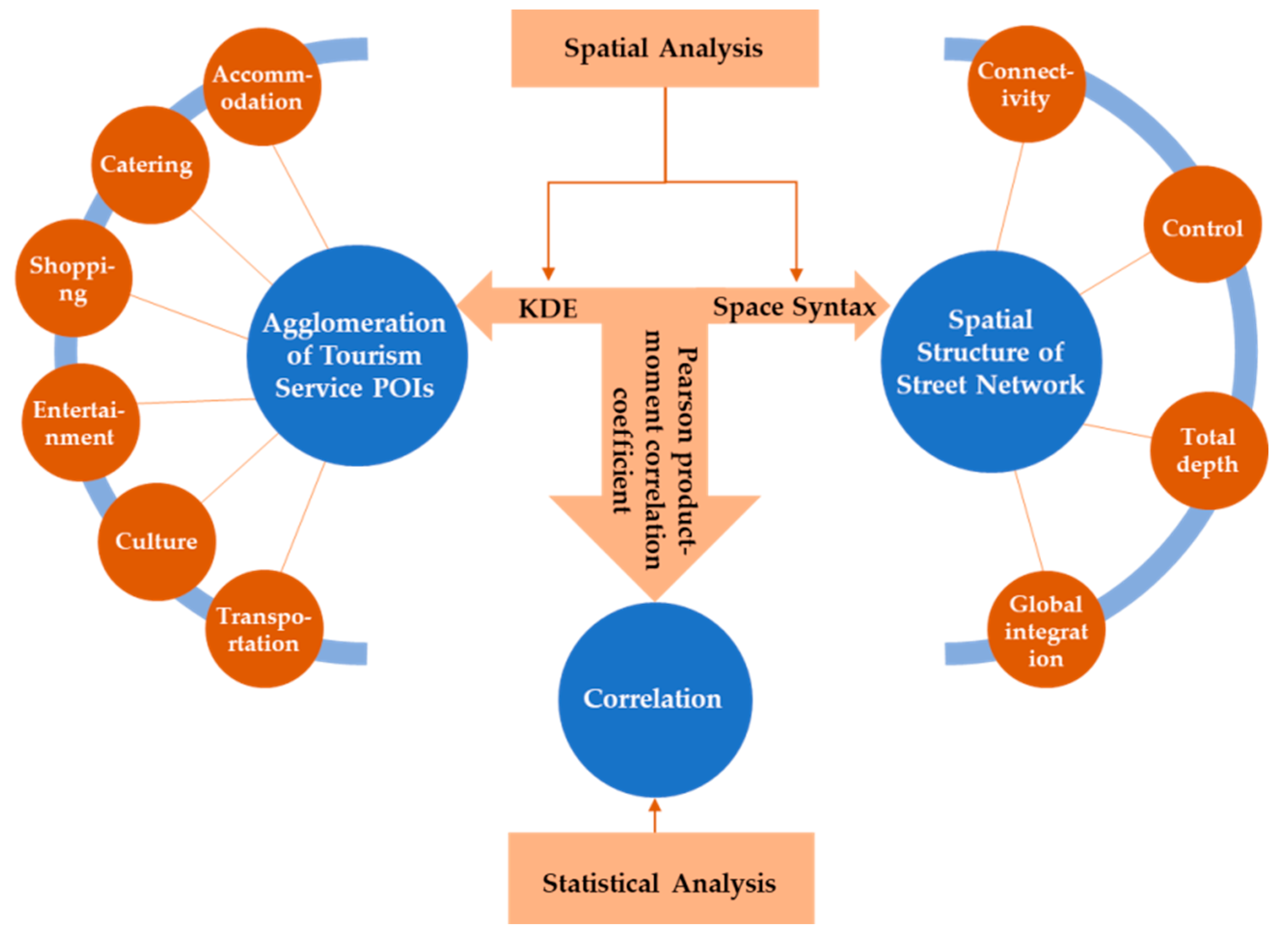
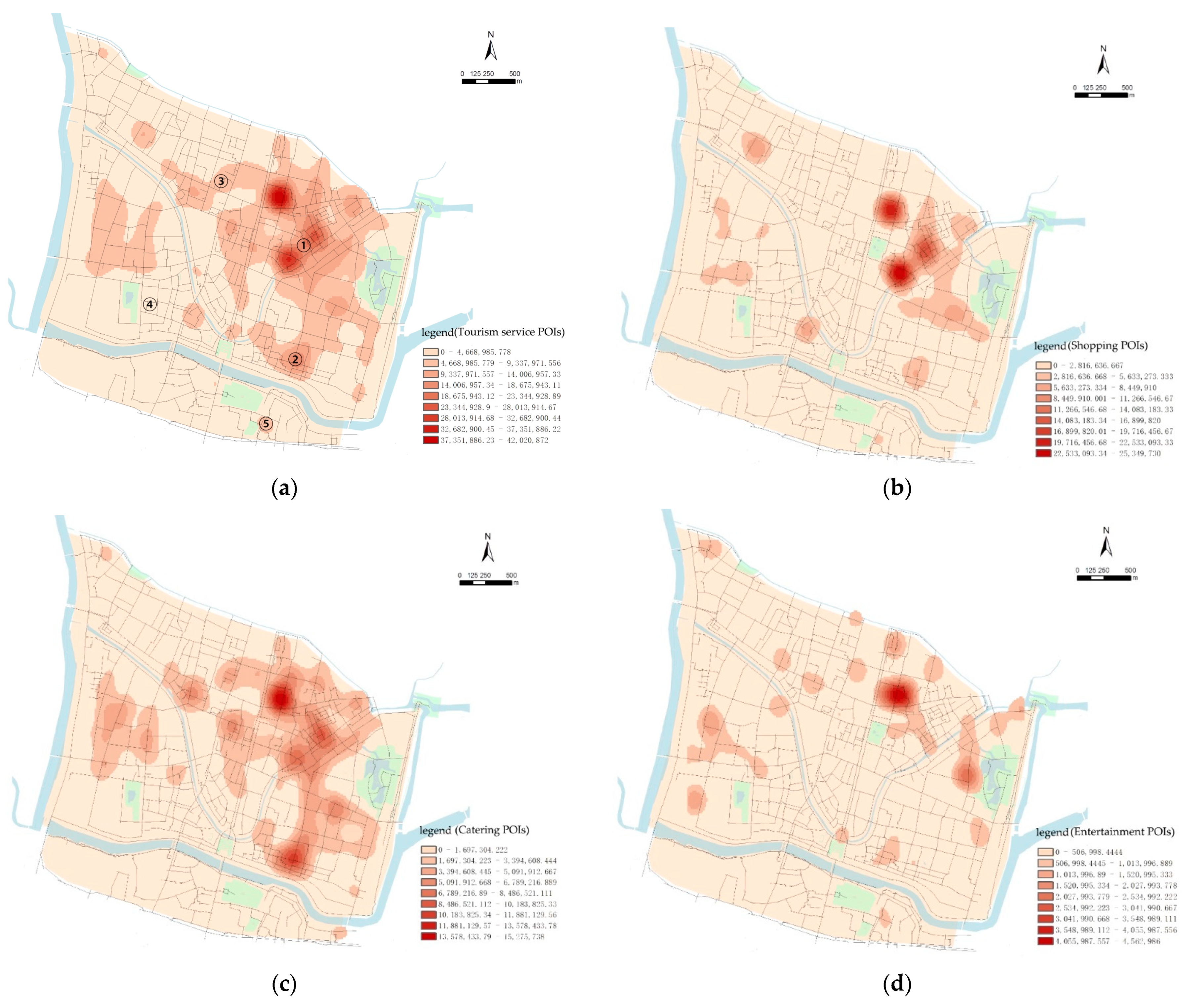
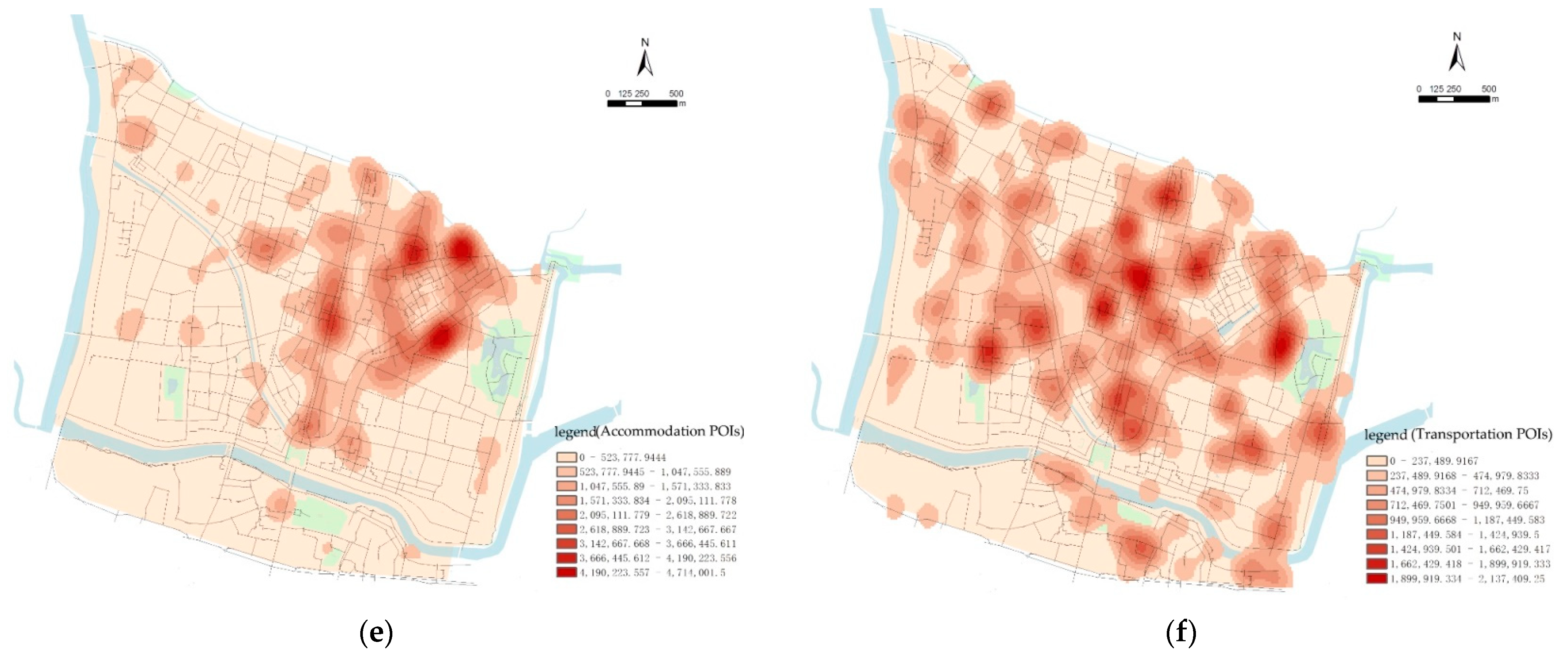
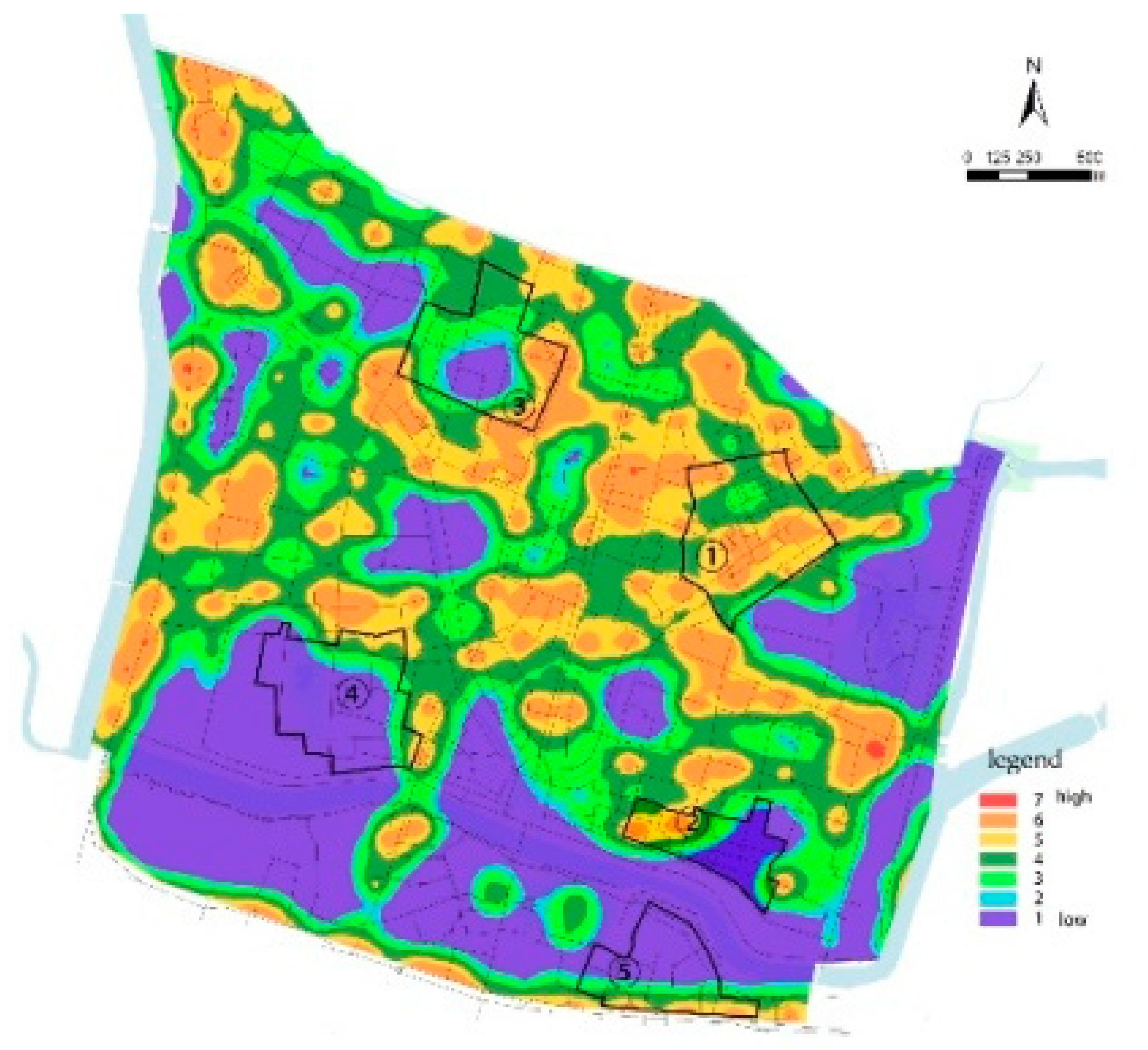

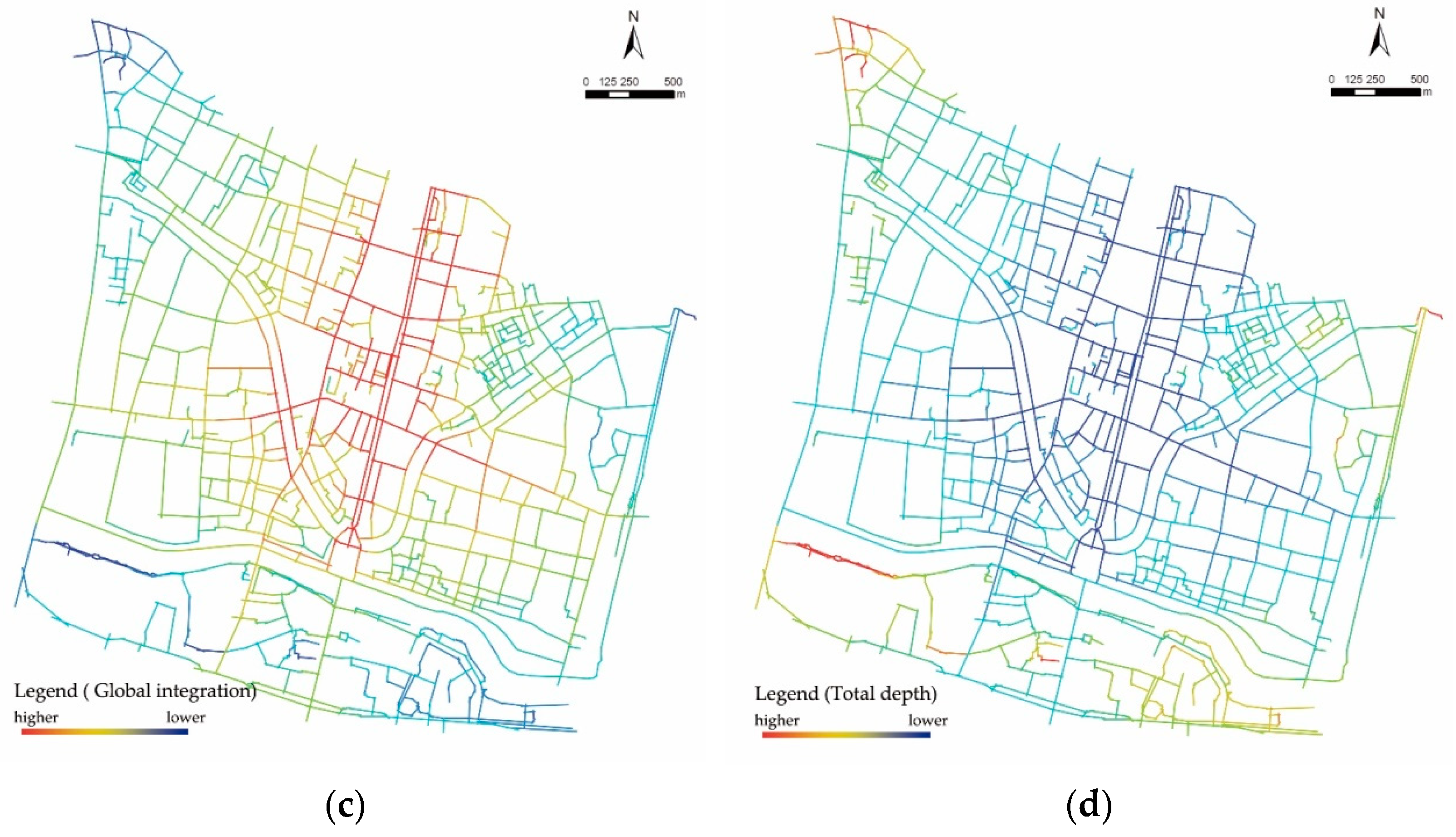
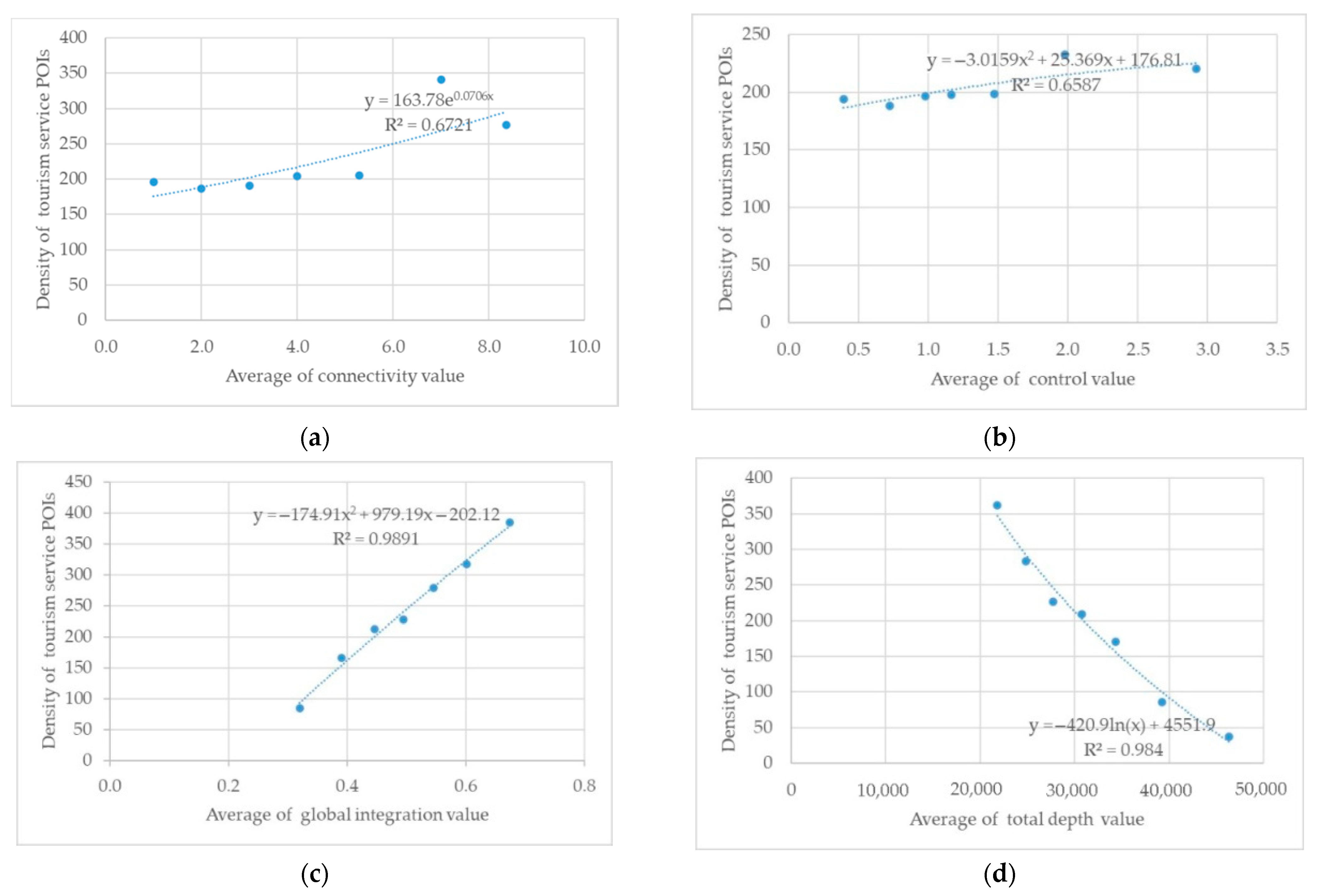
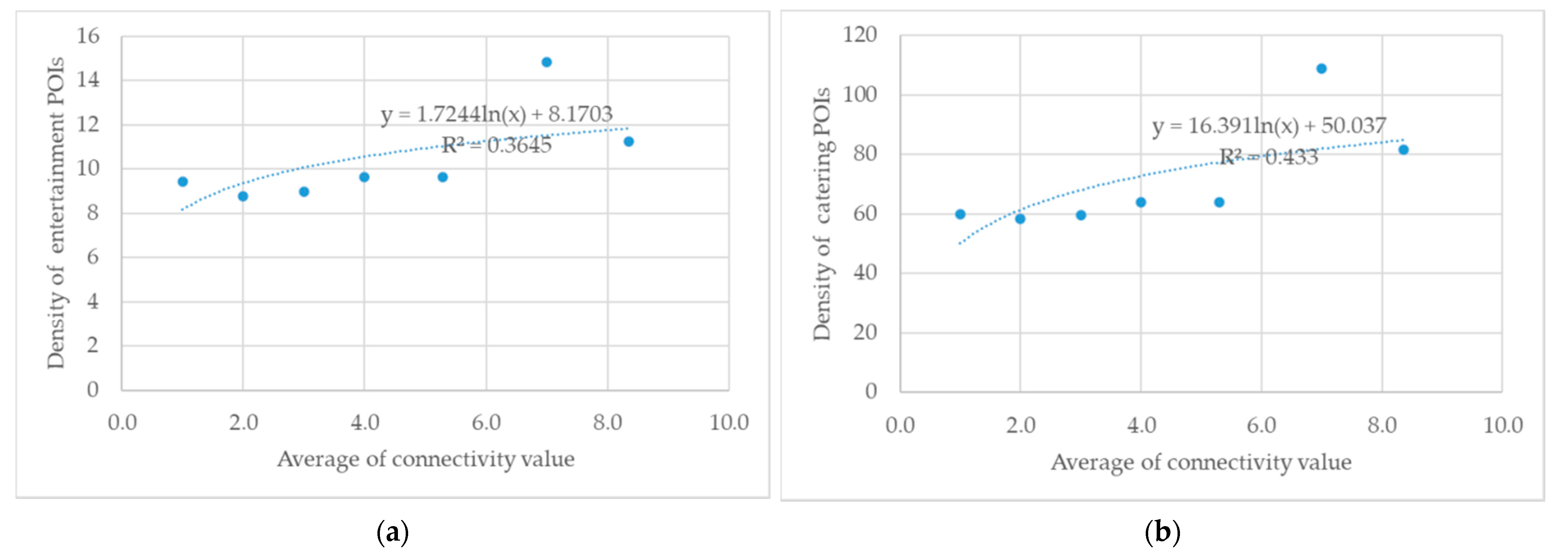
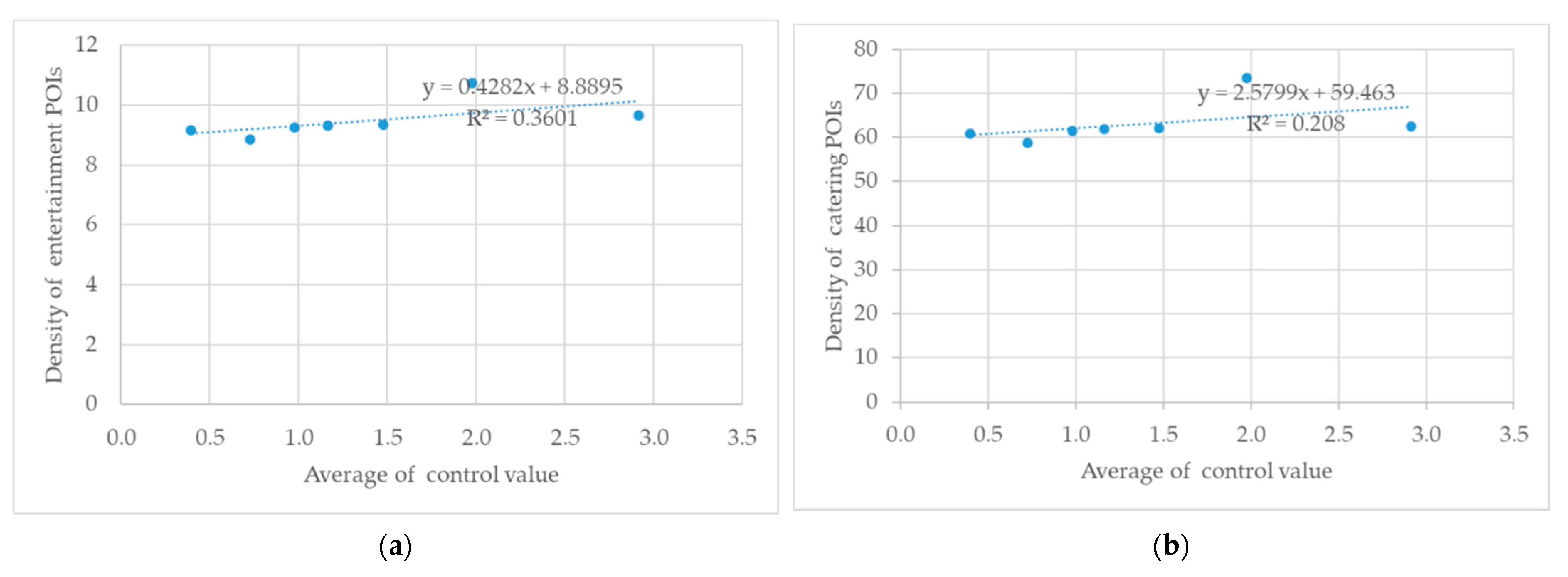
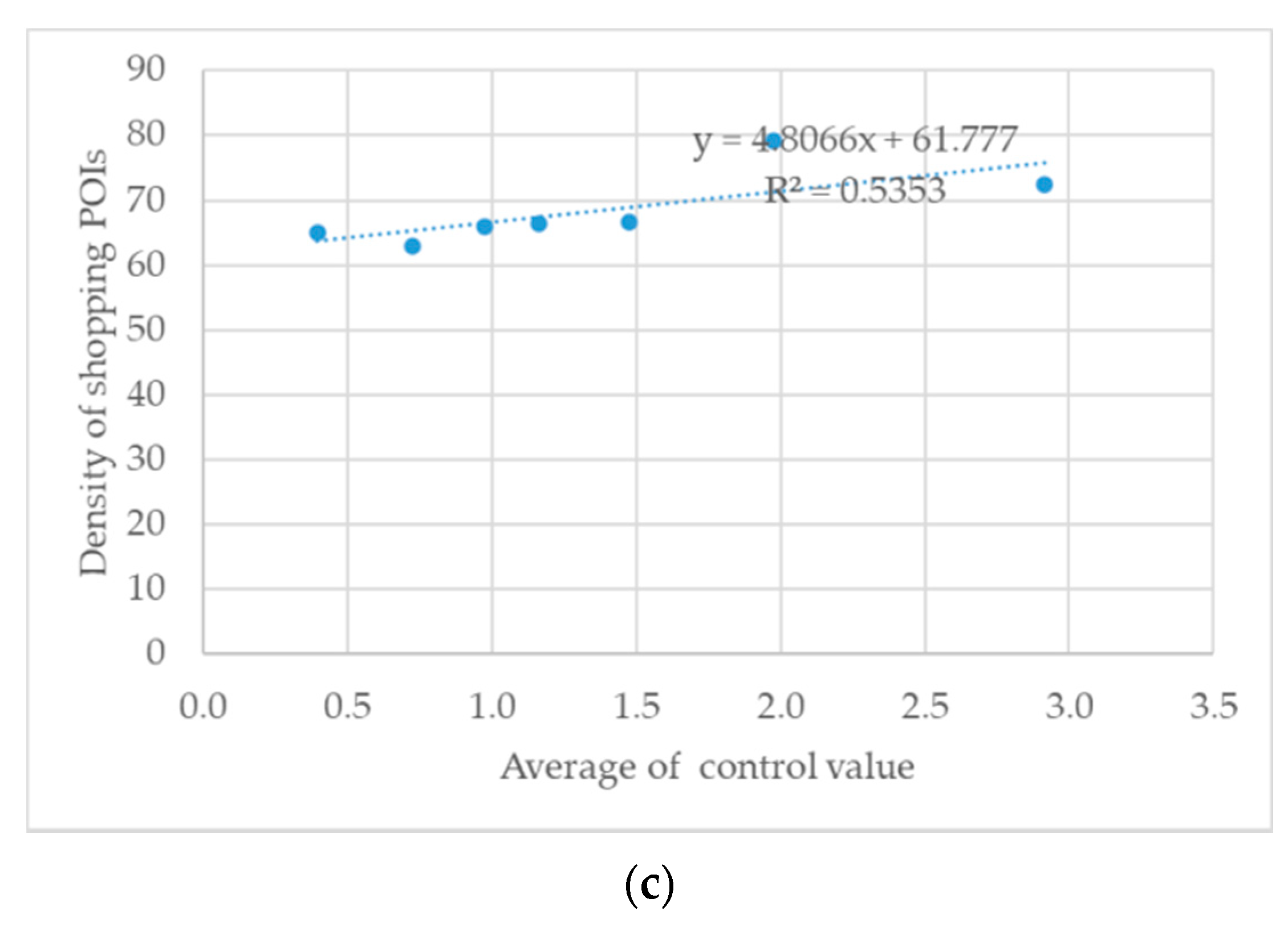
| Type | Description | Number | Ratio |
|---|---|---|---|
| Accommodation | Star hotels, apartment hotels, express hotels, and hostels | 291 | 11.70% |
| Catering | Chinese restaurants, foreign-style restaurants, snack bars, patisseries, cafés, teahouses, and bars | 863 | 34.70% |
| Shopping | Shops, supermarkets, convenience stores, and shopping malls | 925 | 37.19% |
| Entertainment | Sports fitness, Karaoke Television, leisure squares, and bathrooms | 130 | 5.23% |
| Culture | Art galleries and exhibition halls | 25 | 1.01% |
| Transportation | Parking lots and ports | 253 | 10.17% |
| Total | 2487 | 100.00% | |
| Connectivity | Control | Global Integration | Total Depth | ||
|---|---|---|---|---|---|
| Density of tourism service POIs | r | 0.789 * | 0.802 * | 0.994 ** | −0.981 ** |
| Sig. | 0.035 | 0.030 | 0.000 | 0.000 | |
| Density of transportation POIs | r | 0.847 * | 0.887 ** | 0.994 ** | −0.985 ** |
| Sig. | 0.016 | 0.008 | 0.000 | 0.000 | |
| Density of accommodation POIs | r | 0.837 * | 0.941 ** | 0.983 ** | −0.963 ** |
| Sig. | 0.019 | 0.001 | 0.000 | 0.001 | |
| Density of entertainment POIs | r | 0.696 | 0.600 | 0.994 ** | −0.976 ** |
| Sig. | 0.082 | 0.154 | 0.000 | 0.000 | |
| Density of shopping POIs | r | 0.801 * | 0.732 | 0.989 ** | −0.983 ** |
| Sig. | 0.030 | 0.062 | 0.000 | 0.000 | |
| Density of catering POIs | r | 0.747 | 0.456 | 0.996 ** | −0.979 ** |
| Sig. | 0.054 | 0.304 | 0.000 | 0.000 |
Publisher’s Note: MDPI stays neutral with regard to jurisdictional claims in published maps and institutional affiliations. |
© 2021 by the authors. Licensee MDPI, Basel, Switzerland. This article is an open access article distributed under the terms and conditions of the Creative Commons Attribution (CC BY) license (https://creativecommons.org/licenses/by/4.0/).
Share and Cite
Wang, M.; Yang, J.; Hsu, W.-L.; Zhang, C.; Liu, H.-L. Service Facilities in Heritage Tourism: Identification and Planning Based on Space Syntax. Information 2021, 12, 504. https://doi.org/10.3390/info12120504
Wang M, Yang J, Hsu W-L, Zhang C, Liu H-L. Service Facilities in Heritage Tourism: Identification and Planning Based on Space Syntax. Information. 2021; 12(12):504. https://doi.org/10.3390/info12120504
Chicago/Turabian StyleWang, Min, Jianqiang Yang, Wei-Ling Hsu, Chunmei Zhang, and Hsin-Lung Liu. 2021. "Service Facilities in Heritage Tourism: Identification and Planning Based on Space Syntax" Information 12, no. 12: 504. https://doi.org/10.3390/info12120504
APA StyleWang, M., Yang, J., Hsu, W.-L., Zhang, C., & Liu, H.-L. (2021). Service Facilities in Heritage Tourism: Identification and Planning Based on Space Syntax. Information, 12(12), 504. https://doi.org/10.3390/info12120504








